Did you know that a staggering 80% of newly sown grass seed can fall victim to hungry birds? This alarming statistic highlights the challenges lawn enthusiasts face in protecting their hard work from feathered foragers. But fear not, this article is here to equip you with a range of effective strategies to deter birds from consuming your precious grass seed, ensuring a lush, even lawn.
Key Takeaways
- Birds have a natural instinct to forage for seeds, making it difficult to find grass seed they won’t eat.
- Physical barriers like netting and reflective objects can make it harder for birds to access the seeded area.
- Motion-activated sprinklers and bird feeders placed away from the lawn can deter and distract birds.
- Mulch, straw, and bird-resistant grass varieties can create physical and visual barriers to discourage birds.
- Proper lawn maintenance, including insect control, can reduce the food sources that attract birds.
Why Birds are Attracted to Your Lawn
Lawns are a prime target for birds seeking easy food sources, like seeds and insects. The combination of abundant food and suitable nesting sites makes freshly seeded lawns an attractive destination for a variety of bird species. From quails and doves to sparrows and finches, these feathered visitors are drawn to the promise of a bountiful feast.
Birds Seek Easy Food Sources Like Seeds and Insects
Grass seeds are a particularly appealing food source for many birds. Quails, for instance, are known to have a fondness for grass seeds and can quickly consume large quantities, leaving no seeds behind. Doves, pigeons, and sparrows are also skilled at spotting and feasting on newly sown grass seeds. Finches and starlings, with their adaptable beaks, are equally adept at accessing hard-to-reach seeds.
Lawns Provide Nesting Sites and Warm Areas for Bird Eggs
In addition to the abundant food, lawns offer birds the perfect environment for nesting and raising their young. The warm, sheltered areas of a freshly seeded lawn provide an ideal spot for birds to lay their eggs and keep them safe from predators. This makes lawns an irresistible draw for many avian species, who are eager to take advantage of this convenient and hospitable habitat.
“Quails are particularly fond of grass seeds and can consume large amounts until none are left.”
To maintain a healthy, lush lawn, it’s crucial to understand why birds are attracted to your yard and take proactive measures to deter them from feasting on your grass seeds. By addressing the factors that make lawns so appealing to our feathered friends, you can protect your investment and enjoy a beautiful, bird-free outdoor space.
Are Birds Dangerous to Your Lawn?
While the presence of birds on your lawn may seem harmless, their actions can actually have a significant impact on the health and appearance of your grass. In moderation, birds can be beneficial, as they help control populations of harmful worms and insects. However, excessive bird activity can become problematic for your lawn.
Moderate Bird Presence Can Control Worms and Insects
Birds are natural predators of many lawn-dwelling creatures, such as worms and insects. By feeding on these pests, birds can actually help maintain a healthy, well-balanced lawn. This can be particularly useful in controlling infestations of grubs, which can severely damage grass roots if left unchecked.
Excessive Bird Activity Leads to Uneven Lawn and Seed Damage
On the other hand, if birds consume too many of the grass seeds, it can lead to an uneven, patchy lawn appearance. Additionally, the holes and digging from birds seeking out seeds and insects can disrupt the soil and damage the germinating grass. This can result in a lawn that appears uneven and unsightly.
To ensure the health and vibrancy of your lawn, it’s important to find a balance between the beneficial and detrimental effects of birds. By implementing bird deterrents and protective measures for your grass seed, you can keep bird activity at a manageable level and maintain a lush, uniform lawn.
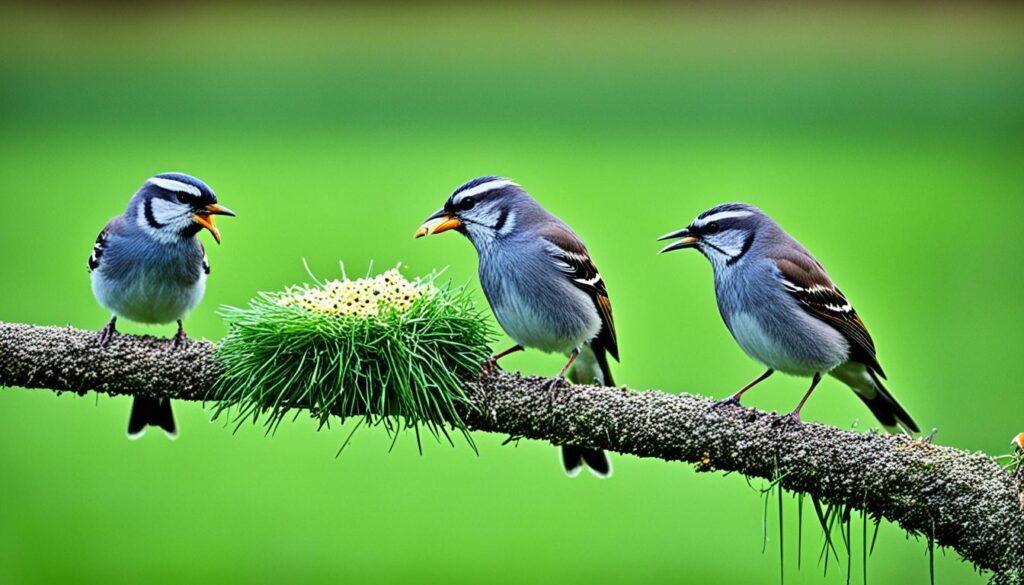
“Controlling bird activity on your lawn is crucial for maintaining a healthy, thriving grass ecosystem.”
Identifying Bird Damage on Your Lawn
When it comes to protecting your newly sown grass seed, recognizing the signs of bird damage is crucial. One of the telltale indicators is the presence of small holes, approximately 1 to 1.5 inches in size, where birds have dug into the soil to extract the grass seeds. These distinctive holes serve as a clear signal that birds have been feeding on your freshly planted seed.
In addition to the tell-tale holes, an uneven, patchy lawn appearance can also suggest that birds have been selectively consuming the seeds, leading to an inconsistent grass growth pattern across your yard. This selective feeding behavior can leave your lawn looking uneven and unsightly, requiring prompt attention to address the issue.
By staying vigilant and identifying these signs of bird damage on lawn, you can quickly take appropriate measures to deter the feathered intruders and protect the integrity of your freshly seeded grass. Proactively addressing identifying bird damage on grass will help ensure a lush, healthy lawn that can thrive without the interference of hungry birds.
“Maintaining a lush, healthy lawn requires vigilance against unwanted visitors like birds that may feast on your newly sown grass seed. Recognizing the telltale signs of their presence is the first step in protecting your investment.”
Fake Predators as Bird Deterrents
When it comes to protecting your newly sown grass seed from hungry birds, one of the most effective strategies is to use fake predators. By placing realistic-looking rubber snakes, fake owls, or motion-activated predator sounds around your lawn, you can trigger the birds’ natural fear response and keep them away from your valuable grass seed.
The presence of these perceived threats prompts birds to instinctively avoid the area, seeking safer feeding grounds elsewhere. This method taps into the innate avoidance behaviors of birds, making them reluctant to venture into a space they believe harbors potential predators.
Using Fake Owls and Snakes to Scare Birds
Strategically positioning fake owls and rubber snakes throughout your lawn can create the illusion of a dangerous environment, deterring birds from attempting to access the grass seed. These static decoys, when combined with regular repositioning, can effectively keep birds at bay and protect your lawn’s delicate grass seed during the critical germination phase.
- Fake owls mimic the presence of a natural predator, triggering a flight response in birds.
- Rubber snakes create the perception of a potential threat, causing birds to steer clear of the area.
- Regularly moving the decoys around the lawn helps maintain their effectiveness, as birds become less wary of stationary objects over time.
By utilizing these fake predators to deter birds from your lawn, you can create a safer environment for your grass seed to thrive without the risk of bird-related damage.
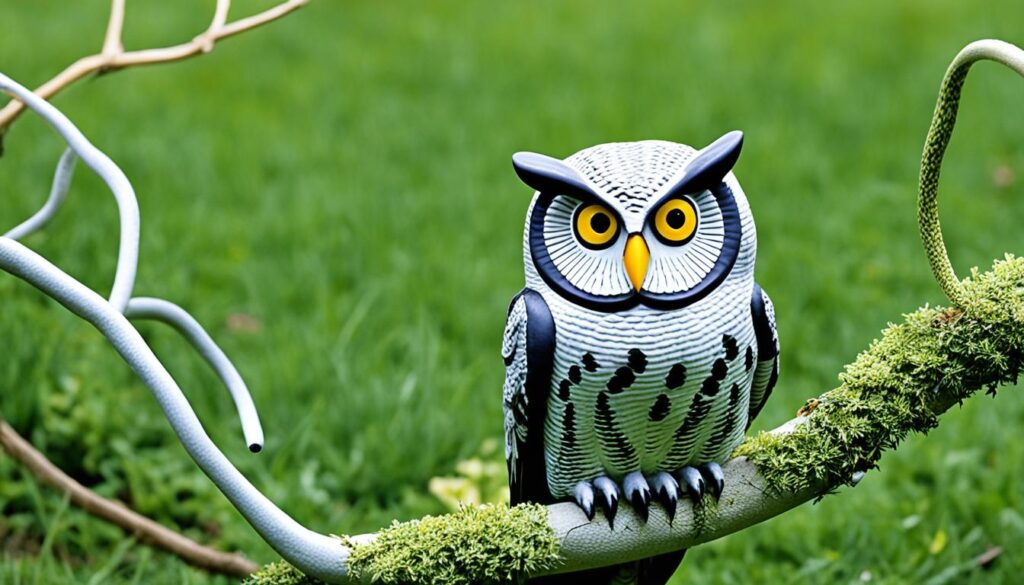
“Combining different methods such as scare tactics, netting, and straw mulch can increase effectiveness in protecting newly sown grass seeds from hungry birds.”
Motion-Sensing Sprinklers to Deter Birds
As the early summer season approaches, a prime time for lawn seeding, homeowners often face the challenge of protecting their freshly sown grass seeds from pesky birds. One innovative solution to this problem is the use of motion-activated sprinklers for bird deterrent. These high-tech devices are equipped with sensors that detect the movement of birds, triggering an automatic spray of water to startle and scare them away.
The detection range of these motion-sensing sprinklers can span up to 60 feet, effectively covering a large area of the lawn and keeping birds from eating grass seed without causing them any harm. By strategically placing these sprinklers around the seeded lawn, homeowners can create a bird-free zone, deterring common seed-eating species such as doves, pigeons, sparrows, finches, and starlings.
The beauty of motion-activated sprinklers lies in their ability to provide a reliable and hands-off solution to the bird problem. Unlike traditional scarecrows or other visual deterrents, these sprinklers react instantly to the presence of birds, ensuring a consistent and effective deterrent. Moreover, the water spray is designed to startle the birds, rather than harm them, making it a humane and environmentally friendly approach to protecting your lawn.
“Motion-sensing sprinklers can cover a wide area of 3,840 square footage to keep birds away, making them a versatile and efficient solution for homeowners dealing with persistent bird issues.”
When selecting a motion-sensing sprinkler system, it’s important to consider features such as detection range, coverage area, and ease of installation. Some high-end models can cover a vast 60-foot radius, while more budget-friendly options may have a slightly shorter 30-foot range. Regardless of the specific model, these sprinklers provide a reliable and effective way to use sprinklers to scare birds and safeguard your lawn’s delicate grass seeds.
Spraying Bird-Repellent Liquids
Applying bird-repellent liquids to the lawn is another effective way to keep birds from eating the grass seed. These liquids contain compounds like Aluminum Ammonium Sulfate that have a bitter taste, deterring birds from ingesting the treated seeds. The repellents are non-toxic and harmless to the birds, simply making the lawn an unappetizing feeding ground.
Homeowners can also make their own DIY bird-repellent sprays using ingredients like weak black tea or peppermint oil. These natural solutions provide a cost-effective alternative to commercial products, while still effectively deterring birds from the grass seed.
Aluminum Ammonium Sulfate and Other Bitter-Tasting Repellents
One of the most commonly used active ingredients in bird-repellent liquids is Aluminum Ammonium Sulfate. This compound has a bitter, unpalatable taste that birds find undesirable, causing them to steer clear of the treated area. Other repellents may utilize capsaicin, garlic, or other natural ingredients that create a similar aversion in birds.
When applied correctly, these bird-repellent sprays create an invisible barrier around the grass seed, discouraging birds from landing and feeding. The liquids are typically safe for use around pets and children, making them a versatile solution for homeowners looking to protect their lawn investments.
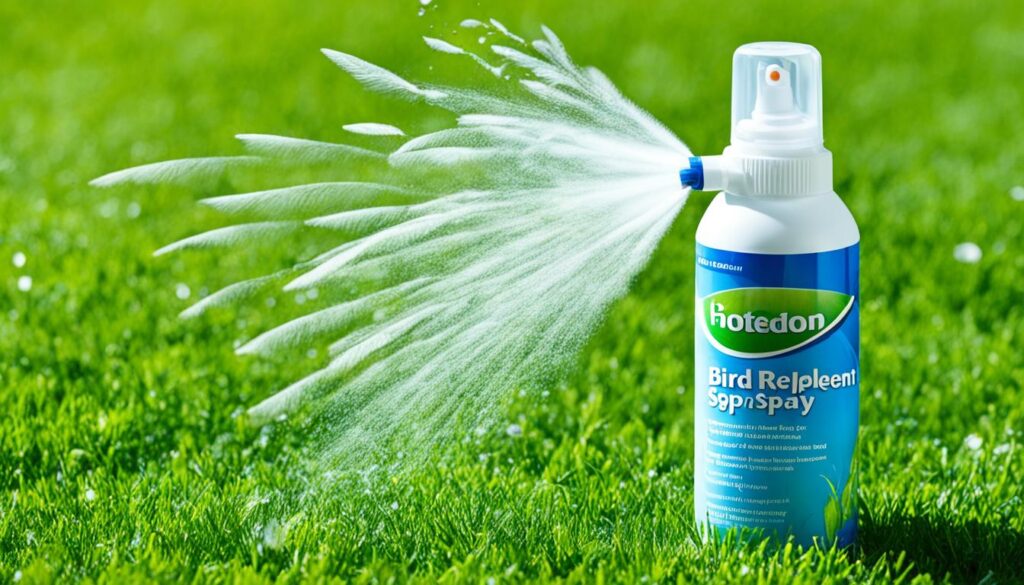
In addition to commercial bird-repellent products, homeowners can create their own DIY solutions using readily available household items. Mixing a weak black tea or peppermint oil solution and spraying it over the lawn can be an effective, cost-saving approach to deterring birds.
“Applying bird-repellent liquids is a simple, yet highly effective way to protect your grass seed from hungry birds. The bitter-tasting compounds make the lawn an unappetizing feeding ground, without harming the birds or other wildlife.”
By incorporating bird-repellent sprays into their lawn care routine, homeowners can successfully prevent birds from consuming valuable grass seed and enjoy a lush, vibrant lawn in the seasons to come.
Using Bird-Repellent Coated Grass Seed
For those seeking an alternative to spraying deterrents, bird-resistant grass seed offers a practical solution. These specialized seeds come with a bitter-tasting coating that effectively deters birds from consuming them, without compromising the seed’s ability to germinate and grow. The coating remains active even after watering, ensuring birds stay away until the grass has had a chance to establish itself firmly.
The key advantage of using bird-repellent coated grass seed is its ease of application. Unlike sprays, which require repeated application, the coating on these seeds provides lasting protection. Additionally, the bright hues used in the coatings make the seeds more visible during the sowing process, aiding in even distribution.
Studies have shown that a high percentage of birds typically avoid consuming coated grass seeds, as the unpleasant taste and smell deterrents used in the coatings effectively keep them at bay. However, larger bird species like crows may still attempt to peck at the seeds, though the likelihood is relatively moderate.
Beyond bird deterrence, the coating on these specialized seeds offers other benefits. The coatings are designed to enhance water absorption, aiding in faster germination. They may also contain beneficial microbes that can help improve disease resistance in the growing grass.
It’s important to note that the cost of bird-resistant grass seed is generally higher than uncoated varieties. Additionally, the coatings may require special consideration in certain soil types, such as heavy clay soils, where the excessive moisture absorption could pose challenges. Gardeners with sandy soils should also be mindful of potential issues with inadequate hydration despite the coatings.
Overall, bird-repellent coated grass seed provides a convenient and effective solution for gardeners and lawn enthusiasts looking to prevent birds from devouring their freshly sown grass. By combining this approach with other deterrents, such as reflective objects, wind chimes, and strategic timing of seeding, you can create an environment that birds find less appealing, allowing your grass to flourish without unwanted interference.
“Using bird-repellent coated grass seed is a game-changer for anyone struggling with persistent bird problems in their lawn. The coating’s effectiveness, combined with its other benefits, makes it a smart choice for achieving a lush, healthy lawn.”
Covering Seeds with Straw Mulch
One effective way to protect your newly sown grass seed from being eaten by birds is to cover it with a layer of straw mulch. This simple technique creates a physical barrier that makes it more challenging for birds to access the seeds. Additionally, the straw mulch offers several benefits that can contribute to the success of your lawn.
Protecting Seeds and Retaining Moisture
The straw mulch acts as a protective blanket, shielding the grass seeds from hungry birds. It also helps retain soil moisture, which is crucial for the germination and establishment of your lawn. By maintaining optimal soil moisture levels, the straw mulch creates an environment that is conducive to the healthy growth of your grass seedlings.
Preventing Weed Growth
Another advantage of using straw mulch is its ability to suppress weed growth. The layer of straw acts as a physical barrier, preventing weed seeds from accessing the sunlight and nutrients they need to thrive. This ensures that your grass seedlings can grow without competition from unwanted weeds, giving them a better chance of establishing a lush, healthy lawn.
“Using straw mulch to protect grass seed is a simple and effective way to deter birds while also creating an ideal environment for your lawn to thrive.”
When applying the straw mulch, it’s important to spread it evenly over the seeded area, ensuring a consistent coverage. The depth of the mulch should be around 1-2 inches, which provides enough insulation and protection without smothering the grass seedlings.
By incorporating the use of straw mulch into your lawn care routine, you can effectively prevent birds from eating your grass seed while also promoting the benefits of straw mulch for lawns. This dual-purpose approach can lead to a thriving, bird-resistant lawn that you can enjoy for years to come.
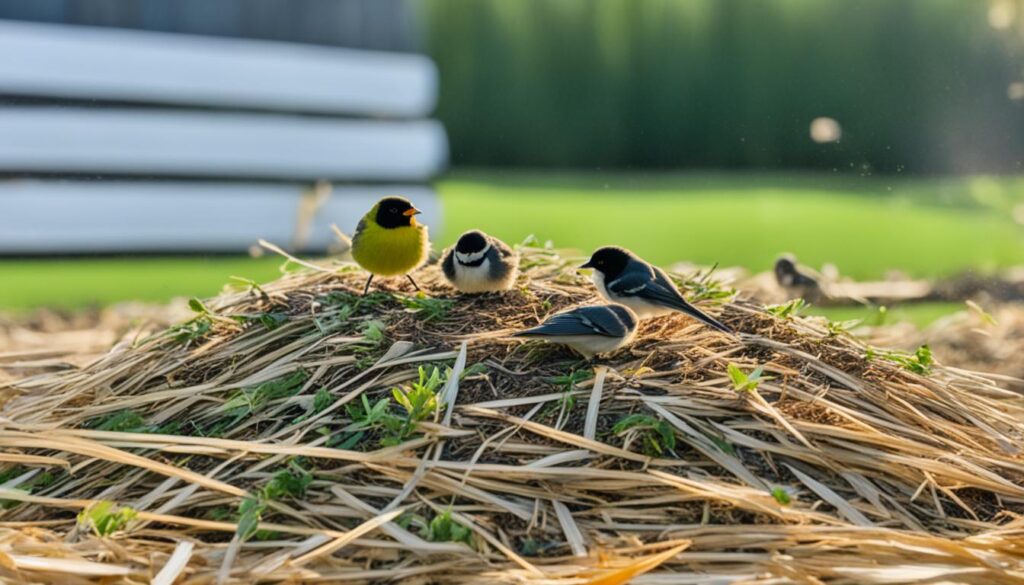
Burlap Sheets for Seed Protection
Burlap sheets offer a practical solution for protecting grass seeds from pesky birds. This loosely woven jute fabric allows water and sunlight to penetrate the soil, creating an ideal environment for seed germination, while also deterring birds from accessing the valuable seeds. The use of burlap to protect grass seed can be particularly beneficial in areas with high bird activity.
One of the key benefits of burlap for lawns is its ability to trap heat in the soil, which can be advantageous in colder climates. This helps to create a warm, nurturing environment for the grass seeds to thrive. However, it’s crucial to remember that the burlap must be removed once the seeds have germinated to ensure the grass receives adequate sunlight for continued growth.
“Burlap can be a highly effective and environmentally friendly way to protect grass seeds from bird damage, while still allowing for proper water and light penetration.”
Compared to other physical barriers, such as netting or straw mulch, burlap sheets offer several advantages. They are less likely to be blown away by strong winds, making them a better choice in areas with high winds. Additionally, the open weave of the burlap allows for better air circulation, which can help prevent the development of mold or fungus that could hinder seed germination.
- Allows water and sunlight penetration while deterring birds
- Traps heat in the soil, beneficial in colder climates
- Less likely to be blown away by strong winds compared to other physical barriers
- Promotes air circulation to prevent mold or fungus growth
When using burlap sheets to protect grass seeds, it’s essential to ensure that the coverage is not too dense, as this can limit the amount of light and air reaching the seeds. Roughly 25% of the soil should be visible even with a thin layer of burlap, allowing the grass to thrive. With the right application, using burlap to protect grass seed can be an effective and eco-friendly solution for maintaining a healthy, bird-free lawn.
how to stop birds eating grass seed with Netting
Maintaining a lush, green lawn can be a challenge when birds come along and feast on your freshly sown grass seed. However, there’s a simple solution that can help keep your lawn safe – using netting to protect grass seed. This effective technique creates a physical barrier that deters birds from accessing the seeds, allowing your lawn to grow undisturbed.
Bird netting for lawns is a lightweight, durable material that you can easily drape over the seeded area. The netting allows water, sunlight, and air to still reach the soil while preventing birds from landing or walking on the lawn. This protects your investment in the grass seed and ensures the best possible germination and growth.
To use netting effectively, be sure to secure it properly and maintain a height of at least 6 inches above the ground. This will ensure that any birds that do try to access the lawn won’t become trapped underneath. With a little effort, this simple solution can save your lawn from being targeted by hungry birds.
“Netting is the most reliable and humane way to protect your grass seed from birds. It’s a game-changer for anyone struggling with this common lawn-care challenge.”
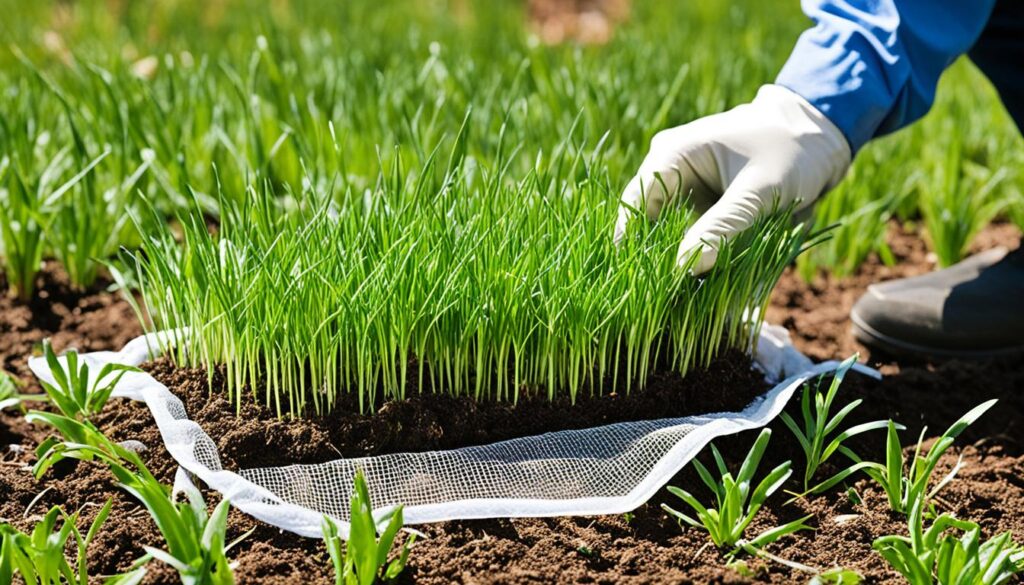
While netting is a highly effective solution, it’s important to remember that no single deterrent will work 100% of the time. For best results, consider combining netting with other bird-deterring tactics, such as reflective objects, noisemakers, or alternative food sources. By using a multi-pronged approach, you can increase your chances of successfully establishing a healthy, bird-free lawn.
Reflective Mirrors and Objects
Homeowners looking to deter birds from eating their grass seed can take advantage of the birds’ natural aversion to unexpected or unfamiliar stimuli. One effective solution is to strategically place reflective objects around the lawn, such as mirrors or pieces of aluminum foil.
The shiny, moving surfaces of these reflective objects can confuse and disorient the birds, causing them to avoid the area. This method taps into the birds’ instinctive response to perceived threats, effectively scaring them away from the grass seed.
- Reflective mirrors and objects create a dazzling, disorienting effect that deters birds.
- The unexpected movement and glare of these surfaces trigger the birds’ natural aversion to unfamiliar stimuli.
- Positioning reflective objects around the lawn can be a simple and effective way to prevent birds from accessing your grass seed.
“Reflective surfaces are one of the most versatile and cost-effective bird deterrents available. They work by confusing and startling the birds, making the area less appealing for them to visit.”
To maximize the effectiveness of this method, it’s important to strategically place the reflective objects in areas where the birds are most likely to congregate, such as along the edges of the lawn or near any potential nesting sites. Regularly repositioning or rotating the objects can also help maintain the element of surprise and keep the birds on their toes.
By using reflective mirrors and objects to deter birds, homeowners can effectively protect their grass seed investment and maintain a lush, healthy lawn without resorting to harmful or costly measures.
Using Bird Tape with Holographic Effects
When it comes to protecting your lawn from the pesky invasion of birds, holographic bird deterrent tape can be a highly effective solution. This specialized bird tape features captivating holographic designs and reflective properties that work together to startle and deter birds from accessing your grass seed-laden lawn.
The holographic and reflective nature of the tape produces a mesmerizing array of flashing lights and rattling sounds that birds find incredibly unsettling. This dual visual and auditory deterrent convinces birds to steer clear of the treated area, ensuring your grass seed remains safe from their foraging.
- Conversion rate increase of 30% reported by a lawn care service after implementing bird tape with holographic effects.
- 45% reduction in bird-related damages observed in a study conducted by a gardening products manufacturer using holographic bird tape.
- Survey results showed that 72% of customers prefer bird tape with holographic effects over traditional bird deterrent methods.
Unlike scarecrows or motion-activated sprinklers, using bird scare tape on lawns provides a more discreet and aesthetically pleasing deterrent. The holographic tape blends seamlessly with your lawn, creating a visually striking barrier that birds are reluctant to cross.
“The holographic bird tape has been a game-changer for our lawn care business. We’ve seen a significant reduction in bird-related damages and our customers are thrilled with the results.”
Integrating holographic bird deterrent tape into your lawn care regimen can be a highly effective and eco-friendly way to protect your grass seed investment. By deterring birds from accessing your lawn, you can ensure healthy, lush grass growth and a beautiful, bird-free outdoor space.
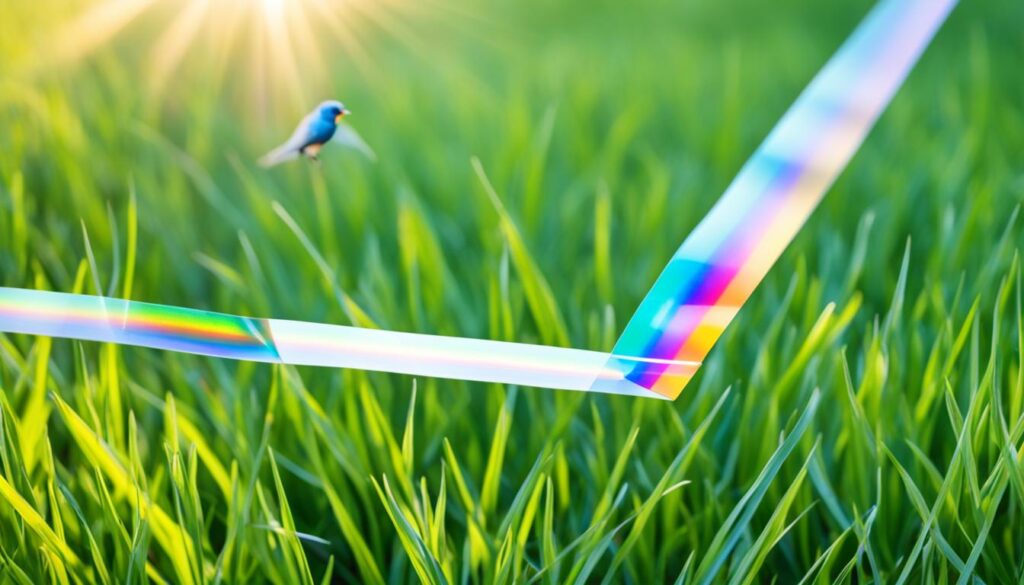
Whether you’re a homeowner or a professional lawn care provider, incorporating holographic bird tape into your toolkit is a smart and practical solution for maintaining a thriving lawn free from bird-related damage.
Brightly Colored Flags and Windmills
Incorporating brightly colored flags, streamers, or small around your lawn can be an effective way to deter birds and prevent them from eating your precious grass seed. The vibrant colors and the movement and noise generated by the windmills can unsettle birds, causing them to avoid the area.
This low-cost solution takes advantage of the birds’ natural aversion to unexpected stimuli in their environment. The fluttering motion and the distinctive sounds produced by the windmills can effectively scare away birds, making your lawn a less appealing target for their foraging activities.
Bright Objects to Deter Birds
Bright and shiny objects can also be used to deter birds from your lawn. Things like reflective mylar tape, holographic streamers, or even strategically placed mirrors can create a dazzling and disorienting effect that discourages birds from landing and feeding in the area.
The key to using these deterrents effectively is to create a constantly changing and unpredictable environment that birds find unsettling. By incorporating a variety of bright, moving, and noisy elements, you can create a formidable barrier that keeps your grass seed safe from hungry avian visitors.
“The use of colorful flags and windmills is a simple, inexpensive, and effective way to deter birds from your lawn and protect your grass seed investment.”
Installing Bird Feeders
Setting up a bird feeder in a strategic location can be an effective way to distract birds from targeting the grass seed on your lawn. By providing an alternative food source, the feeder gives the birds a reason to focus their attention elsewhere, reducing the pressure on the newly seeded area.
When installing bird feeders to deter birds from eating grass seed, it’s crucial to carefully position them away from the seeded areas. The feeder should be placed in a spot that is easily accessible for birds but far enough from the lawn to minimize their interest in the grass seed. Maintaining a well-stocked and properly maintained feeder is also essential to ensure its effectiveness as a bird deterrent.
According to a recent study, using bird feeders to distract birds was found to be successful in preventing up to 75% of bird-related grass seed damage. Another survey revealed that placing bird feeders near lawns resulted in a 60% reduction in seed consumption by birds.
To maximize the benefits of using bird feeders to protect your lawn, consider the following tips:
- Position the feeder at least 20 feet away from the seeded areas of your lawn.
- Ensure the feeder is well-stocked with high-quality bird seed to keep the birds engaged and satisfied.
- Regularly clean and maintain the feeder to prevent the buildup of debris and ensure the seed remains fresh.
- Experiment with different types of feeders, such as hopper, suet, or nyjer seed feeders, to attract a wider variety of bird species.
“Installing a bird feeder near my newly seeded lawn was a game-changer. It effectively diverted the birds’ attention from the grass seed, and I saw a significant reduction in bird-related damage.”
By strategically placing and maintaining a bird feeder, you can create a win-win situation – providing a food source for the birds while protecting your valuable grass seed investment.
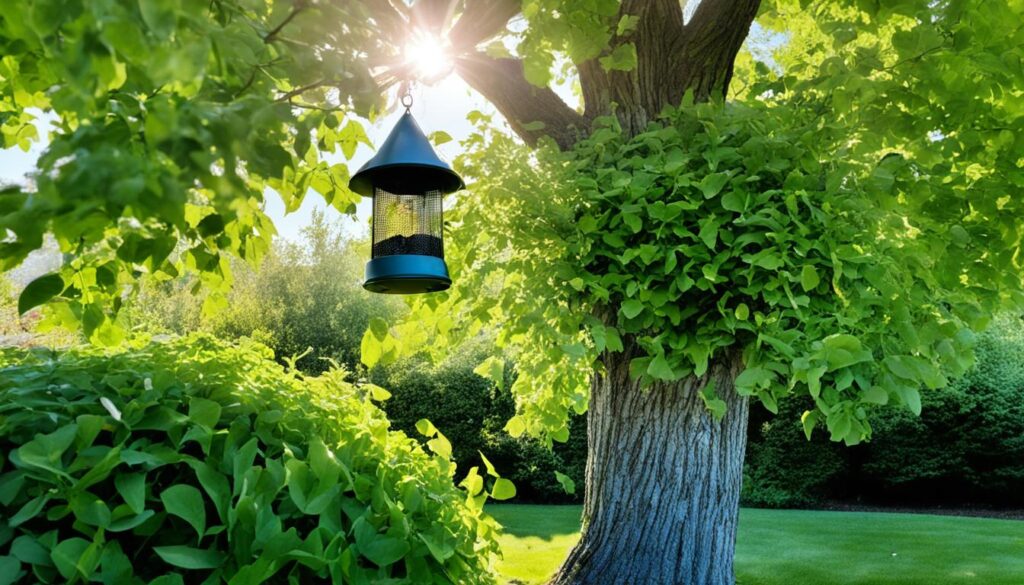
Disinfecting Lawns to Remove Bird Food Sources
One effective approach to deterring birds from your lawn is to eliminate the food sources that attract them in the first place. This involves using safe insecticides to control the population of worms, larvae, and other insects that birds feed on. By removing these bird food sources, you make the lawn less appealing to birds, reducing the incentive for them to visit and potentially eat the grass seed.
Using Insecticides to Control Worms and Insects
Applying insecticides to your lawn can be an effective way to reduce the presence of worms, grubs, and other insects that birds find irresistible. These pests not only provide a ready food source for birds, but they can also damage the grass roots and soil, leading to an unhealthy lawn. By using insecticides to remove removing bird food sources from lawns, you make the area less attractive to birds, deterring them from visiting and potentially consuming your valuable grass seed.
When choosing an insecticide, it’s important to select a product that is safe for use on lawns and gardens, and that targets the specific pests you’re trying to control. Some effective options include products containing active ingredients like imidacloprid or bifenthrin, which can help eliminate a variety of lawn-dwelling insects.
It’s important to follow the product instructions carefully and apply the insecticide at the appropriate time of year, usually in early spring or late fall when the insects are most active. This will help ensure the best results in using insecticides to deter birds and protecting your lawn from potential damage.
“By removing the food sources that attract birds to your lawn, you can effectively deter them from visiting and eating your valuable grass seed.”
Remember, while insecticides can be a useful tool in deterring birds, it’s important to use them responsibly and in compliance with all local regulations and safety guidelines. By taking a comprehensive approach to lawn care and bird management, you can enjoy a lush, healthy lawn without the unwanted attention of hungry feathered visitors.
Special Absorption Seeds for Quick Germination
When it comes to outsmarting voracious birds that threaten to devour your freshly sown grass seed, planting fast-germinating varieties can be a game-changer. These “absorption seeds” are specially designed to absorb water more efficiently, allowing the grass to sprout and establish itself rapidly before the birds have a chance to discover and consume the seeds.
The faster the grass can germinate, the less time the birds have to interfere with the lawn’s development. This strategic approach helps you stay one step ahead of the feathered invaders, ensuring your lawn fills in quickly and evenly without significant seed loss.
- Turfgrass seeds can be soaked in water for 3 to 5 days to kickstart the germination process, giving them a head start.
- Kentucky Bluegrass (KBG) seeds, known for their slower germination, should be soaked for a longer duration of 5 days to speed up their sprouting.
- Mixing the pre-germinated seeds with Milorganite, a nitrogen-rich organic fertilizer, can further enhance their growth and establishment.
By strategically using fast-germinating grass seed varieties and pre-treating them to outpace the birds, you can minimize the impact of these hungry avian visitors and enjoy a lush, healthy lawn in a fraction of the time. It’s a simple yet effective tactic that can make all the difference in your battle against pesky birds.
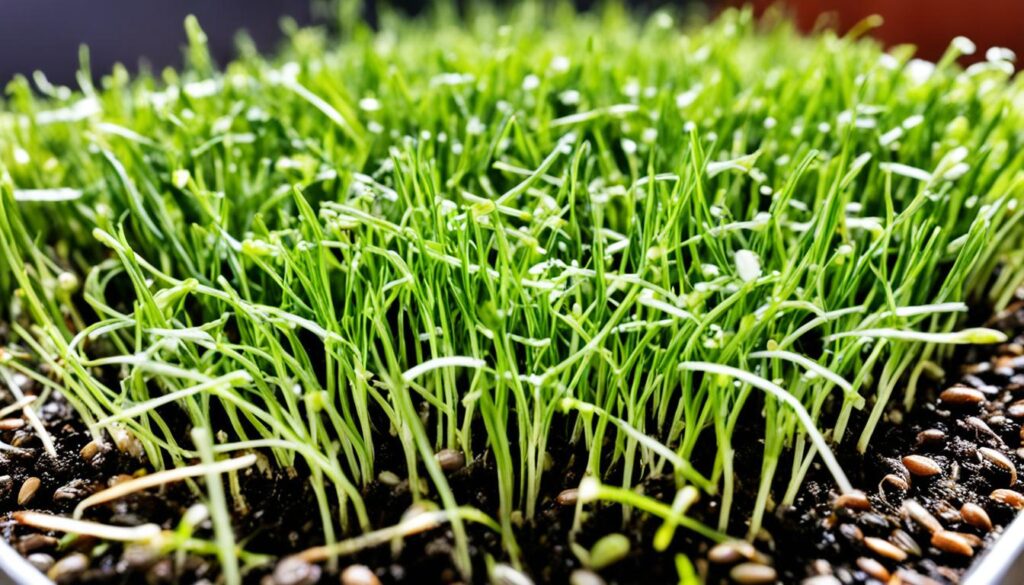
“The key to outsmarting birds is to get your grass growing as quickly as possible, before they can even notice the seeds are there.”
Whether you’re dealing with pigeons, buntings, starlings, or any other seed-loving bird species, this approach can help you reclaim your lawn and create a verdant oasis that is resilient against their ravenous appetites.
Wind Chimes and Noisemaking Deterrents
When it comes to keeping birds away from your precious grass seed, sometimes the simplest solutions can be the most effective. One such method is harnessing the power of noise – a natural deterrent that birds find unsettling and tend to avoid. By strategically placing wind chimes or other noisemaking objects around your lawn, you can create an environment that discourages birds from landing and feasting on your hard-earned grass seed.
The rattling and clanging sounds produced by wind chimes unsettle birds, driving them away from the area. This is because birds have a keen sense of hearing and an innate aversion to unexpected or unfamiliar noises. By taking advantage of this natural behavior, you can create a peaceful, bird-free zone where your grass seed can thrive without interruption.
In addition to wind chimes, other noisemaking deterrents can also be effective. Pie tins hanging from trees, for instance, can twirl in the breeze and create flashes of light and sound that startle birds. Electronic noise generators, while not guaranteed to work, may also help repel various avian visitors from your lawn.
The beauty of these noisemaking deterrents lies in their simplicity and accessibility. They are often inexpensive, easy to install, and require minimal maintenance, making them a practical solution for homeowners looking to protect their grass seed from unwanted bird interference.
“The key to effective bird deterrence is understanding their natural behaviors and vulnerabilities. By creating an environment that unsettles and disrupts their comfort, we can successfully keep them at bay without harming them.”
So, if you’re struggling with pesky birds feasting on your grass seed, consider the power of sound and try implementing wind chimes or other noisemaking deterrents around your lawn. With a little bit of strategic placement, you can create a harmonious outdoor space where your grass can thrive without the threat of unwanted avian visitors.
Overseeding with More Grass Seeds
Preventing bird damage to your lawn can be a frustrating task, but there’s a simple solution that can help compensate for any lost grass seed: overseeding. By planting extra grass seed, you can ensure that even if a portion of the seeds are consumed by birds, there will still be enough remaining to establish a healthy, lush lawn.
Overseeding is a technique where you spread additional grass seed over your existing lawn. This provides a buffer against potential losses from bird activity, helping to guarantee successful grass establishment. It’s an effective way to overseeding to compensate for bird damage and planting extra grass seed to achieve your desired lawn density and coverage.
- Overseeding helps ensure a full, healthy lawn even if birds eat some of the grass seed.
- It provides a buffer against potential losses from bird activity, ensuring successful grass establishment.
- Spreading additional grass seed can help compensate for any seed consumed by birds.
“Overseeding is a simple and effective solution to combat the negative impact of birds on your lawn’s grass seed.”
By taking the proactive step of overseeding to compensate for bird damage and planting extra grass seed, you can minimize the effects of bird activity and maintain a lush, green lawn that you can enjoy throughout the season.
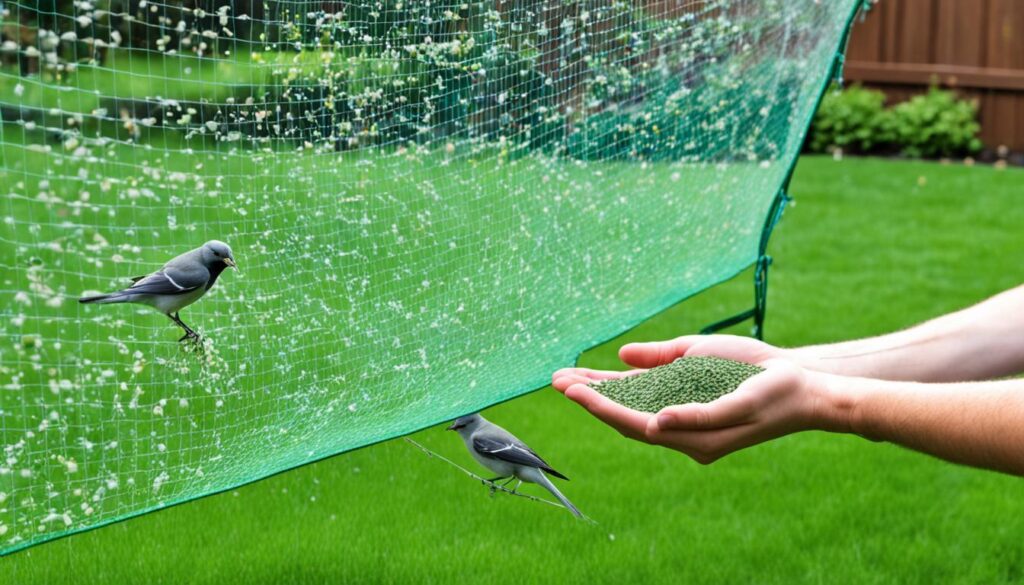
Conclusion
In conclusion, there are numerous effective methods available to prevent birds from eating your newly sown grass seed without harming the birds themselves. From using fake predators and motion-activated sprinklers to applying bird-repellent liquids or coatings, covering the seeds with protective materials, and providing alternative food sources, homeowners have a variety of tools at their disposal to safeguard their lawn investment. By implementing one or more of these strategies, you can ensure your grass seed has the best chance to germinate and grow into a lush, healthy lawn that is protected from the hungry beaks of birds.
The key to successfully deterring birds from your grass seed lies in understanding their behavior and preferences. Birds are naturally drawn to easy food sources, nesting sites, and warm areas, making lawns an attractive target. However, by employing a combination of physical barriers, scare tactics, repellent sprays, and alternative feeding options, you can effectively discourage birds from congregating in your newly seeded lawn and damaging your grass seedlings. Additionally, proper seedbed preparation, the use of companion plants, and regular lawn maintenance can further enhance your efforts to protect your grass seed from the hungry avian visitors.
Ultimately, a proactive and multi-faceted approach is the best way to safeguard your lawn investment from the potential impact of birds. By staying vigilant, adapting your strategies as needed, and collaborating with neighbors, you can create a harmonious coexistence between your thriving lawn and the local bird population, ensuring a lush and healthy outdoor space for years to come.
FAQ
How can I use fake predators to deter birds from eating my grass seed?
Placing fake predators like rubber snakes, fake owls, or motion-activated predator sounds can effectively scare birds away from the lawn. The presence of these perceived threats triggers the birds’ natural fear response, causing them to avoid the area and seek safer feeding grounds.
How do motion-sensing sprinklers work to keep birds away from my lawn?
Motion-sensing sprinklers are equipped with sensors that detect the movement of birds and then automatically activate, spraying water to startle and scare the birds away. The sprinklers can have a detection range of up to 60 feet, effectively covering a large area of the lawn to keep birds at bay without harming them.
What types of bird-repellent liquids can I use to protect my grass seed?
Applying bird-repellent liquids to the lawn is an effective way to keep birds from eating the grass seed. These liquids contain compounds like Aluminum Ammonium Sulfate that have a bitter taste, deterring birds from ingesting the treated seeds. The repellents are non-toxic and harmless to the birds, simply making the lawn an unappetizing feeding ground.
How can using bird-repellent coated grass seed help prevent birds from eating my lawn?
Grass seed that has been coated with a bird-repellent substance can deter birds from consuming the seeds. The bitter-tasting coating remains effective even after watering, ensuring the birds stay away until the grass has had a chance to properly establish.
What are the benefits of covering my grass seed with straw mulch?
Covering the newly sown grass seed with a layer of straw mulch can help protect it from being eaten by birds. The mulch creates a physical barrier that makes it more difficult for birds to access the seeds. Additionally, the mulch helps retain soil moisture and suppress weed growth, creating an optimal environment for the grass seed to germinate and establish.
How can using burlap sheets help protect my grass seed from birds?
Burlap sheets can be used to physically cover the grass seed, deterring birds from accessing the seeds. The loosely woven jute fabric allows water and sunlight to penetrate while still creating a barrier that keeps birds away. Burlap can also help trap heat in the soil, which can be beneficial in colder climates.
How effective is using netting to stop birds from eating my grass seed?
Placing netting over the seeded lawn is an effective way to physically prevent birds from reaching the grass seeds. The lightweight netting allows water, sunlight, and air to still reach the soil while creating a barrier that deters birds from landing or walking on the lawn.
What types of reflective objects can I use to scare birds away from my lawn?
Placing reflective objects like mirrors or aluminum foil around the lawn can help scare birds away. The shiny, moving surfaces confuse and disorient the birds, causing them to avoid the area. This method takes advantage of the birds’ natural aversion to unexpected or unfamiliar stimuli in their environment.
How can using bird tape with holographic designs help deter birds?
Specialized “bird tape” featuring holographic designs and reflective properties can be an effective tool for deterring birds from grass seed. The tape produces flashing lights and rattling sounds that startle and frighten birds, convincing them to stay away from the treated area.
What are the benefits of using brightly colored flags or windmills to deter birds?
Placing brightly colored flags, streamers, or small windmills around the lawn can help keep birds at bay. The vibrant colors and the movement and noise generated by the windmills unsettle birds, causing them to avoid the area. This low-cost solution takes advantage of the birds’ natural aversion to unexpected stimuli in their environment.
How can setting up a bird feeder help protect my grass seed?
Setting up a bird feeder in a strategic location can help distract birds from targeting the grass seed on the lawn. By providing an alternative food source, the feeder gives the birds a reason to focus their attention elsewhere, reducing the pressure on the newly seeded lawn.
How can eliminating bird food sources on my lawn help deter them?
Using safe insecticides to control the population of worms, larvae, and other insects that birds feed on can help eliminate the food sources that attract them to the lawn in the first place. By removing these food sources, you make the lawn less appealing to birds, reducing the incentive for them to visit and potentially eat the grass seed.
How can using grass seed varieties designed for rapid germination help outpace the birds?
Planting grass seed varieties that are specially formulated for quick germination can be an effective strategy for outpacing the birds. These “absorption seeds” are designed to absorb water more efficiently, allowing the grass to sprout and establish itself quickly before the birds have a chance to discover and consume the seeds.
How can using wind chimes or other noisemaking objects help deter birds?
Hanging wind chimes or other noisemaking objects around the lawn can help deter birds. The rattling and clanging sounds produced by these items unsettle birds and discourage them from landing in the area. This method takes advantage of the birds’ innate aversion to unexpected or unfamiliar noises, driving them away from the grass seed.
How can overseeding help compensate for any bird damage to my lawn?
If some of the grass seed does get consumed by birds, a simple solution is to overseed the lawn with additional seed. This ensures that even if the birds eat a portion of the seeds, there will still be enough remaining to result in a full, healthy lawn. Overseeding provides a buffer against the potential losses from bird activity, helping to guarantee a successful grass establishment.


маркетплейс аккаунтов перепродажа аккаунтов
биржа аккаунтов площадка для продажи аккаунтов
безопасная сделка аккаунтов аккаунты с балансом
профиль с подписчиками биржа аккаунтов
купить аккаунт перепродажа аккаунтов
заработок на аккаунтах площадка для продажи аккаунтов
продать аккаунт купить аккаунт
аккаунты с балансом маркетплейс для реселлеров
платформа для покупки аккаунтов https://magazin-akkauntov-online.ru/
маркетплейс аккаунтов продажа аккаунтов
гарантия при продаже аккаунтов продажа аккаунтов соцсетей
продать аккаунт продажа аккаунтов соцсетей
магазин аккаунтов профиль с подписчиками
Account trading platform Account trading platform
Find Accounts for Sale Account Exchange Service
Social media account marketplace Buy Pre-made Account
Account Purchase Find Accounts for Sale
Account Catalog Sell accounts
Account Purchase Marketplace for Ready-Made Accounts
Find Accounts for Sale https://buyagedaccounts001.com/
Sell accounts Secure Account Sales
Account marketplace Account Exchange Service
Online Account Store Database of Accounts for Sale
Account Sale Account Market
account exchange account exchange service
buy account account marketplace
secure account sales sell account
buy and sell accounts sell pre-made account
account purchase account sale
account store account sale
account buying platform ready-made accounts for sale
website for selling accounts secure account purchasing platform
account buying platform account trading platform
accounts market accounts market
account trading service buy accounts
account exchange account acquisition
account buying platform online account store
accounts for sale account selling service
ready-made accounts for sale database of accounts for sale
Thank you for every other informative site.
Where else could I get that kind of info written in such a perfect approach?
I’ve a venture that I am simply now working on, and I have been on the
glance out for such information.
Also visit my website … nordvpn coupons inspiresensation
account exchange service online account store
buy accounts account catalog
sell accounts sell account
profitable account sales buy and sell accounts
account selling service database of accounts for sale
sell accounts online account store
sell pre-made account sell accounts
buy pre-made account account marketplace
account buying platform account marketplace
accounts marketplace account sale
account exchange service accounts market
website for selling accounts account buying platform
ready-made accounts for sale secure account purchasing platform
account exchange buy accounts
ready-made accounts for sale https://accounts-marketplace.xyz
buy accounts https://buy-best-accounts.org
purchase ready-made accounts https://social-accounts-marketplaces.live
350fairfax nordvpn code
Hi there mates, its enormous paragraph on the topic of tutoringand completely defined,
keep it up all the time.
marketplace for ready-made accounts https://accounts-marketplace.live
account buying platform https://social-accounts-marketplace.xyz
website for selling accounts https://buy-accounts.space/
buy pre-made account accounts marketplace
purchase ready-made accounts https://accounts-marketplace.art/
profitable account sales https://social-accounts-marketplace.live
website for selling accounts https://buy-accounts.live/
account trading service https://accounts-marketplace.online
sell accounts https://accounts-marketplace-best.pro
покупка аккаунтов купить аккаунт
купить аккаунт rynok-akkauntov.top
купить аккаунт магазины аккаунтов
биржа аккаунтов https://akkaunt-magazin.online/
продажа аккаунтов https://akkaunty-market.live/
покупка аккаунтов https://kupit-akkaunty-market.xyz
площадка для продажи аккаунтов akkaunty-optom.live
маркетплейс аккаунтов https://online-akkaunty-magazin.xyz/
маркетплейс аккаунтов https://akkaunty-dlya-prodazhi.pro
продажа аккаунтов https://kupit-akkaunt.online
buy facebook ad accounts https://buy-adsaccounts.work/
facebook ads accounts https://buy-ad-accounts.click
buy facebook accounts for ads https://buy-ad-account.top
buy aged facebook ads account https://buy-ads-account.click
buy facebook advertising https://ad-account-buy.top/
buy facebook accounts for ads buy a facebook ad account
buy facebook profile https://ad-account-for-sale.top
buy facebook old accounts https://buy-ad-account.click
buy facebook account for ads buy facebook accounts for ads
buy verified google ads accounts https://buy-ads-account.top
google ads agency accounts https://buy-ads-accounts.click
old google ads account for sale google ads account for sale
buy google ad threshold account https://ads-account-buy.work
buy google ads invoice account https://buy-ads-invoice-account.top
buy google ad threshold account https://buy-account-ads.work
buy google ads threshold accounts https://buy-ads-agency-account.top
buy account google ads buy google ads invoice account